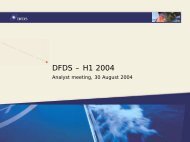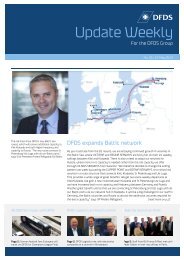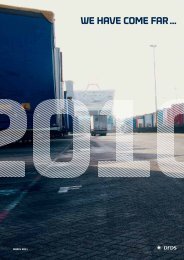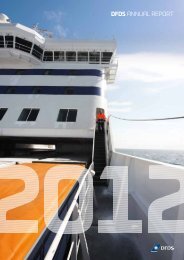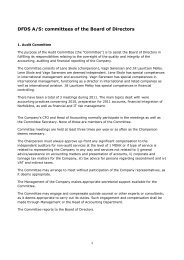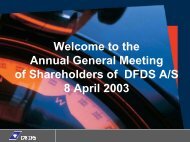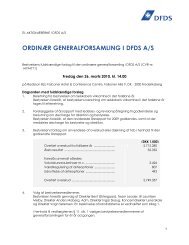English - DFDS
English - DFDS
English - DFDS
Create successful ePaper yourself
Turn your PDF publications into a flip-book with our unique Google optimized e-Paper software.
<strong>DFDS</strong> annual report 2009 STRATEGY 9<br />
Implementation<br />
GROUP MANAGEMENT<br />
Implementation of the strategy involves three primary focus areas:<br />
n Expansion of the route network to more regions in Northern Europe,<br />
particularly in and around the Baltic Sea<br />
n Integration of passenger activities in the network<br />
n Securing higher volumes.<br />
RO-RO<br />
SHIPPING<br />
CONTAINER<br />
SHIPPING<br />
PASSENGER<br />
SHIPPING<br />
TERMINAL<br />
SERVICES<br />
TRAILER<br />
SERVICES<br />
The route network will mainly be expanded through acquisitions, which<br />
will also serve to consolidate the network in selected areas. Both these<br />
objectives are supported by the acquisition of Norfolkline.<br />
Approval of the Norfolkline acquisition will limit the need to make<br />
further major acquisitions related to the United Kingdom and the<br />
North Sea. Future expansion of the route network will therefore<br />
focus on other European regions in which <strong>DFDS</strong> will be able to reap<br />
benefits from a larger network.<br />
<strong>DFDS</strong>’s passenger competences, which have been built up primarily<br />
through cruise-ferry activities, are now to a greater extent employed<br />
across both cruise-ferry and ro-pax concepts. This development will<br />
continue, and it is expected that growth within passenger activities will<br />
be driven first and foremost by ro-pax-oriented concepts.<br />
Securing volumes for the route network is done in three ways.<br />
Firstly, co-operation agreements and relationships with transport<br />
companies will continue to be developed to mutual advantage.<br />
Secondly, the aim is to continue to grow the proportion of industrial<br />
logistics through more and longlasting partnerships. Thirdly, <strong>DFDS</strong>’<br />
own trailer activities will be selectively expanded to add volume on<br />
specific routes, which the expected acquisition of Norfolkline also will<br />
contribute to.<br />
Business structure<br />
<strong>DFDS</strong>’ business structure consists of five areas: The business areas<br />
Ro-Ro Shipping, Container Shipping and Passenger Shipping are<br />
responsible for different activities on the route network as a whole,<br />
while the business areas Terminal Services and Trailer Services<br />
support the network.<br />
The sale of freight solutions across business areas and the network<br />
in general is co-ordinated by a separate organisational unit, Freight<br />
Sales Solutions.<br />
Financial targets<br />
FREIGHT SALES SOLUTIONS<br />
GROUP FUNCTIONS<br />
<strong>DFDS</strong>’ long-term financial objective is a return on invested capital<br />
(ROIC) on a level that exceeds the Group’s cost of capital by 30-50 %.<br />
The cost of capital (WACC) in the beginning of 2010 was calculated at<br />
6.5 %. This includes a risk-free interest rate of 3.75 %, equivalent to a tenyear<br />
Danish government bond, a market risk premium of 5.0 %, a beta<br />
value of 0.94, a borrowing rate before tax of 5.0 %, a tax rate of 10.5 %<br />
and a capital structure with a 50/50 distribution. The capital structure<br />
is the ratio between equity and net interest-bearing debt. The management<br />
report contained in this annual report for 2009 outlines the<br />
current and long-term achievement of these objectives.<br />
It is furthermore an objective to maintain a solidity of<br />
approximately 40 %.



